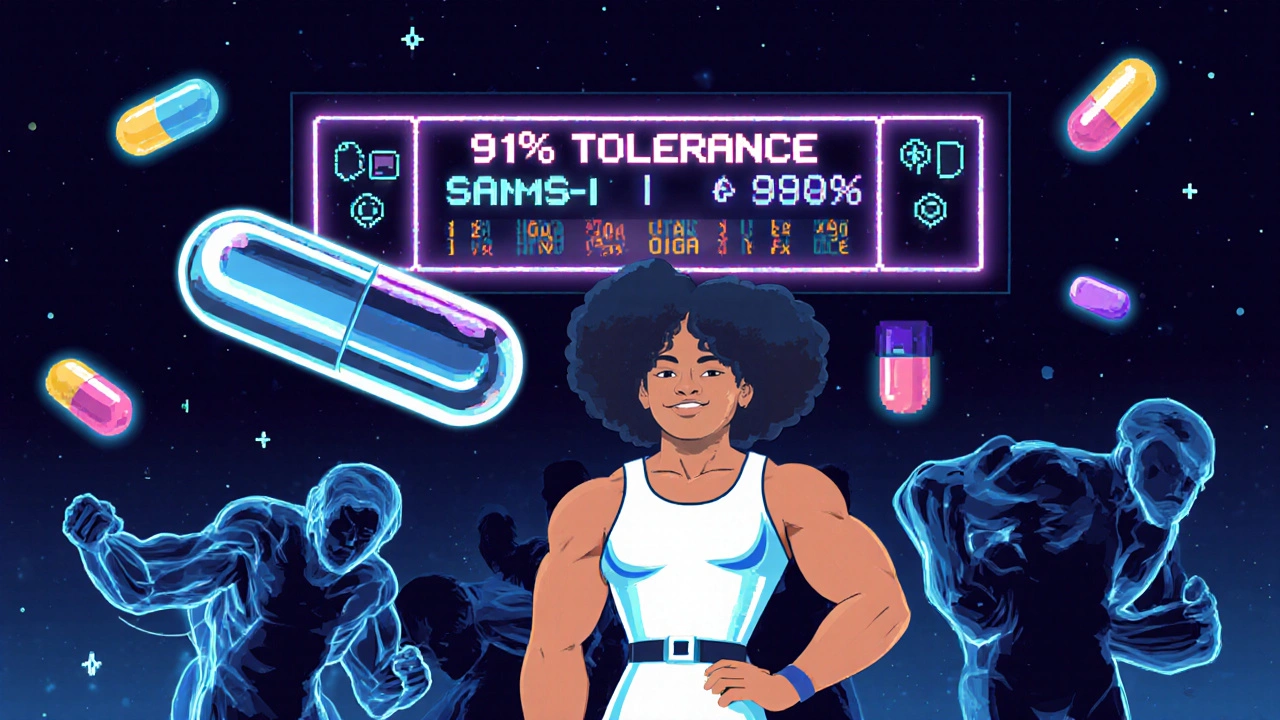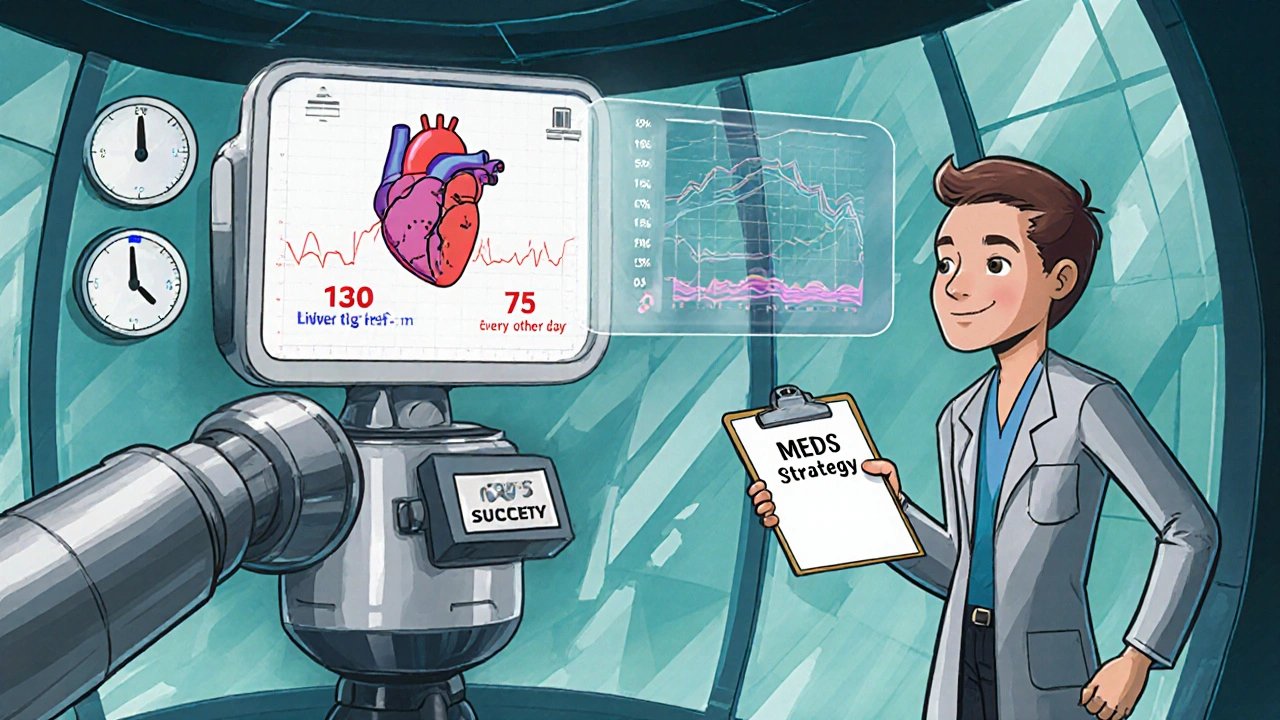Rechallenge After Statin-Induced Myopathy: Safe Strategies to Restart Statin Therapy
 Oct, 31 2025
Oct, 31 2025
Statin Rechallenge Success Calculator
Not all muscle pain from statins is caused by statins. In fact, studies show that about 5% of people on statins and 5% on placebos report muscle aches — that's the nocebo effect. This calculator helps you determine your likelihood of successfully restarting statin therapy with the right approach.
Your Rechallenge Assessment
Recommended Strategy
When muscle pain hits after starting a statin, it’s easy to assume the drug is the culprit. Many patients stop taking it right away - and never go back. But here’s the truth: statin-induced myopathy is often not what it seems. Most people who quit statins due to muscle symptoms could safely restart them with the right approach. The real danger isn’t the statin - it’s staying off it when you need it most.
What Really Causes Statin Muscle Pain?
Not all muscle pain from statins is caused by statins. In fact, studies show that in double-blind trials, about 5% of people on statins report muscle aches - and so do about 5% of people on sugar pills. That’s not a coincidence. It’s the nocebo effect: if you expect side effects, your brain starts to feel them, even if the drug isn’t responsible. True statin myopathy is rare. Severe cases like rhabdomyolysis - where muscle tissue breaks down dangerously - happen in fewer than 1 in 1,000 people. Most cases are mild: soreness, weakness, or stiffness that shows up after exercise or at the end of the day. The key is figuring out if it’s really the statin, or just bad timing, stress, or another condition like low vitamin D, thyroid issues, or arthritis.When to Try Rechallenge - And When Not To
Before you even think about restarting a statin, symptoms need to fully resolve. That usually takes 2 to 4 weeks after stopping. If you still feel sore after a month, you might have something else going on. Check your creatine kinase (CK) levels and thyroid function. If CK is more than 40 times the normal limit, you’ve had rhabdomyolysis - and you should not restart any statin. That’s a hard stop. There’s one big exception: immune-mediated necrotizing myopathy. This is a rare autoimmune reaction triggered by statins, marked by positive anti-HMGCR antibodies. If you have this, statins are off-limits forever. You’ll need immunosuppressants like prednisone or IVIG. But this affects less than 1% of people with statin muscle symptoms. For everyone else, rechallenge is not just safe - it’s often the best way to protect your heart.The MEDS Strategy: A Proven Way to Restart Statins
Experts agree on a simple, step-by-step plan called MEDS:- Minimize time off - Stay off statins no longer than 4 weeks. Every extra week increases your risk of a heart attack or stroke.
- Education - Understand the difference between real side effects and the nocebo effect. Many patients feel better just knowing their symptoms might not be from the drug.
- Diet and nutraceuticals - Coenzyme Q10, vitamin D, and omega-3s may help reduce muscle discomfort. They won’t fix everything, but they can lower the dose you need.
- Monitoring - Check CK levels and how you feel at 2 and 4 weeks after restarting. Track symptoms in a journal.

How to Rechallenge: 4 Proven Methods
You don’t have to go back to the same statin at the same dose. Here’s what actually works:- Switch statins - Some are easier on muscles. Pravastatin and fluvastatin have the lowest risk. Avoid simvastatin, especially at high doses. Rosuvastatin and atorvastatin are stronger but can be used at lower doses.
- Reduce the dose - Drop from 40 mg to 20 mg, or even 10 mg. You still get 70-80% of the cholesterol-lowering benefit. A 10 mg dose of atorvastatin cuts LDL by about 35% - enough for many people.
- Try every-other-day dosing - Take your statin every 48 hours instead of daily. This keeps cholesterol low while giving muscles time to recover. Studies show this works for 30% of people who failed daily dosing.
- Use a low-intensity statin - If you’re not at very high risk for heart disease, a low-dose statin might be enough. The goal isn’t to hit the lowest possible LDL - it’s to reduce risk without causing pain.
One patient, a 68-year-old woman with a history of heart attack, switched from simvastatin 40 mg to pravastatin 20 mg every other day. Her muscle pain vanished. Her LDL dropped from 130 to 75. She’s been on it for three years.
What If Rechallenge Fails?
About 20-30% of people still can’t tolerate any statin. That’s frustrating - but not hopeless.- PCSK9 inhibitors (evolocumab, alirocumab): These injectable drugs lower LDL by 50-60%. They’re proven to cut heart attacks and strokes. The catch? They cost about $5,850 a month - unless your insurance covers them. Most insurers approve them after you’ve tried and failed at least two statins.
- Ezetimibe: This pill lowers LDL by 15-20%. It’s cheap, safe, and works well with low-dose statins. Even if you can’t take statins, ezetimibe alone helps.
- Bempedoic acid: A newer oral option that lowers LDL by 20-30%. It’s less likely to cause muscle pain because it works in the liver, not muscles.
Don’t assume alternatives are better just because they’re newer. Statins are still the gold standard. They’ve been studied in millions of people over decades. Alternatives are powerful, but they’re not magic.
Why Most Doctors Don’t Offer Rechallenge
A 2021 survey found that 73% of patients who quit statins due to muscle pain were never offered a rechallenge plan. Why?- Doctors are afraid of liability.
- They don’t know the SAMS-CI tool (Statin-Associated Muscle Symptom Clinical Index).
- They assume muscle pain = statin intolerance.

What You Can Do Today
If you’re off statins because of muscle pain:- Wait 2-4 weeks to make sure symptoms are gone.
- Ask for a CK blood test and thyroid check.
- Request the SAMS-CI score - or ask your doctor to calculate it.
- Propose switching to pravastatin or fluvastatin at half your old dose.
- Ask about every-other-day dosing.
- If your doctor says no, ask for a referral to a lipid clinic.
Don’t accept “you’re statin intolerant” as a life sentence. That label is often wrong. With the right plan, most people can get back on statins - and protect their heart for years to come.
Genetics and Future Options
If you’ve tried multiple statins and kept having muscle pain, genetic testing might help. The SLCO1B1 gene affects how your body clears statins. The *5 variant makes simvastatin build up in your muscles - increasing risk 5-fold. If you have this variant, avoid high-dose simvastatin entirely. New tools like the ACC’s Statin Intolerance Calculator now include genetic data, age, kidney function, and drug interactions to give personalized rechallenge advice. It’s not perfect - but it’s better than guessing.Final Thought: Your Heart Can’t Wait
Stopping statins because of muscle pain might feel like the safe choice. But the real risk isn’t a sore leg - it’s a heart attack you could have prevented. Rechallenge isn’t risky. It’s responsible. With the right strategy, you can get the benefits of statins without the pain.Can I restart a statin after stopping due to muscle pain?
Yes, in most cases. If your muscle symptoms have fully resolved after 2-4 weeks and you didn’t have rhabdomyolysis or immune-mediated myopathy, rechallenge is safe and recommended. Up to 80% of people succeed with a modified approach like switching statins, lowering the dose, or using every-other-day dosing.
Which statin has the lowest risk of muscle pain?
Pravastatin and fluvastatin carry the lowest risk of muscle-related side effects. Rosuvastatin and atorvastatin are more potent but can be used at lower doses (10 mg) with good tolerance. Avoid high-dose simvastatin (especially 80 mg), which has the highest myopathy risk.
Is every-other-day statin dosing effective?
Yes. Studies show that taking a statin every 48 hours (e.g., Monday, Wednesday, Friday) maintains LDL-lowering effects for most people. It’s especially helpful for those who had muscle pain on daily dosing. About 30% of patients who failed daily therapy succeed with this schedule.
What if I still get muscle pain after rechallenge?
If pain returns, stop the statin again and consult a lipid specialist. You may need genetic testing (SLCO1B1), a different statin, or non-statin options like ezetimibe, bempedoic acid, or PCSK9 inhibitors. Don’t keep trying the same approach - a different strategy or specialist input is needed.
Are PCSK9 inhibitors worth the cost?
For people who truly can’t tolerate statins and are at high risk for heart attack or stroke, yes. PCSK9 inhibitors reduce LDL by over 50% and cut heart events by 15-17%. While they cost about $5,850 a month, most insurers approve them after two failed statin trials. Generic statins cost $4-$10 a month - but if you can’t take them, PCSK9 inhibitors are the next best option.
Can supplements like CoQ10 help with statin muscle pain?
Some people report less discomfort with CoQ10, vitamin D, or omega-3s, but studies show mixed results. They won’t fix true statin intolerance, but they may help reduce muscle symptoms enough to allow a lower statin dose. They’re safe to try alongside medical guidance.
How do I know if my muscle pain is really from statins?
The SAMS-CI (Statin-Associated Muscle Symptom Clinical Index) is the best tool. It’s a 7-question score that predicts whether your symptoms are likely caused by statins. A low score means you have a 91% chance of tolerating rechallenge. Ask your doctor to use it - or find an online version from the American College of Cardiology.
Should I get genetic testing for statin intolerance?
If you’ve tried multiple statins and kept having muscle pain, yes. The SLCO1B1 *5 variant makes simvastatin build up in muscles, increasing risk. Testing can guide safer choices - like avoiding simvastatin entirely. It’s not needed for everyone, but it’s valuable for those with recurrent issues.
Pradeep Kumar
November 1, 2025 AT 05:06Man, I’ve seen so many folks in India stop statins after a little leg cramp-then end up in the ER with a heart attack. This post? Gold. CoQ10 and every-other-day dosing saved my uncle’s life. He’s now on pravastatin 20mg every 48 hours, no pain, LDL at 72. 🙌
Justin Vaughan
November 1, 2025 AT 07:38It’s wild how we treat statin muscle pain like a death sentence when it’s usually just the nocebo effect in disguise. I used to tell patients, ‘Your brain is playing tricks on you.’ Then I started showing them the placebo arm data-and boom, 7 out of 10 came back. The real villain? Fear. Not the pill.
Manuel Gonzalez
November 2, 2025 AT 09:07Good breakdown. I’ve been prescribing the MEDS strategy for years. The biggest hurdle isn’t the science-it’s the patient’s belief that ‘if it hurt once, it’ll hurt again.’ Education is the real medicine here.
Andy Ruff
November 2, 2025 AT 18:03Let’s be real-most people who quit statins are just lazy. They don’t want to take a pill every day, so they invent ‘muscle pain’ as an excuse. And now doctors are coddling them with every-other-day dosing and CoQ10? This isn’t medicine, it’s appeasement. If you’re at risk for heart disease, you take the pill. Period.
Hazel Wolstenholme
November 3, 2025 AT 14:46How quaint. You speak of MEDS as if it were a sacred scripture, yet you omit the elephant in the room: the pharmaceutical-industrial complex has spent billions conditioning physicians to believe statins are the only path to cardiovascular salvation. The real question isn’t whether rechallenge works-it’s whether we’re pathologizing normal aging and conflating cholesterol with morality. Your ‘80% success rate’ is a placebo-controlled fantasy dressed in clinical jargon. The heart doesn’t need statins-it needs systemic change, not pharmacological band-aids.
Joseph Kiser
November 4, 2025 AT 22:29Bro, I get it. You’re scared. I was too. I stopped statins after my calves felt like concrete. Then I tried pravastatin 10mg every other day + vitamin D. No pain. LDL dropped 40%. I cried. Not because I’m emotional-because I realized I almost killed myself by listening to internet gurus. This isn’t about pills. It’s about not letting fear steal your future. You got this. 💪
Roy Scorer
November 6, 2025 AT 07:47You’re all missing the point. Statins are a symptom of a broken system. We’ve turned health into a product to be consumed-pills for every ache, every fear, every natural variation in human biology. Your ‘rechallenge’ is just another form of medical colonization. You don’t need a statin-you need to stop eating processed food, move your body, and sleep. But that’s too hard, right? So we give you a pill and call it progress.
Matthew Kwiecinski
November 7, 2025 AT 07:17Pravastatin and fluvastatin have the lowest myopathy risk? That’s not even close to accurate. The data shows pitavastatin has the lowest incidence. You’re citing outdated studies. Also, every-other-day dosing only works for statins with long half-lives-atorvastatin and rosuvastatin. Fluvastatin’s half-life is 2-3 hours. That regimen would be useless. Don’t spread misinformation.
Ajay Kumar
November 8, 2025 AT 12:59Every-other-day dosing? That’s just a workaround for people who can’t follow a simple daily routine. And CoQ10? I’ve seen patients spend $50 a month on supplements while ignoring their sugar intake. You’re not fixing the problem-you’re just rearranging deck chairs on the Titanic. Real solution? Diet. Exercise. No pills.
Mike Laska
November 9, 2025 AT 23:32I stopped statins because my legs felt like they were being stabbed with ice picks. I tried everything-CoQ10, vitamin D, switching drugs. Nothing worked. Then I found out I had undiagnosed hypothyroidism. My CK was through the roof. I started levothyroxine. Three weeks later, I was walking without wincing. I’m back on a low-dose atorvastatin now. My point? Don’t assume it’s the statin. Look for the hidden stuff. Your body’s screaming. Listen.
Marcia Facundo
November 11, 2025 AT 11:58I’m off statins. I don’t care what you say. I feel better. End of story.